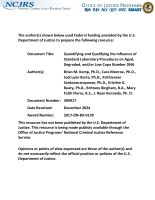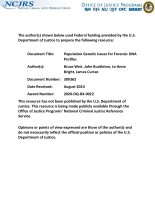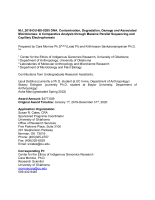Trace DNA
Technical Note: A novel method for simultaneous recovery of DNA, RNA, and proteins from trace biological samples for forensic application
Touch DNA Evidence Collection in Sexual Assault Cases
Dr. Julie L. Valentine introduces the application of touch DNA in sexual assault cases through a case study. A literature review on touch DNA is summarized to provide contextual information and research on touch DNA analysis findings in groping sexual assault cases is discussed. The webinar concludes with recommendations for multidisciplinary partners to collect, submit, and analyze evidence in sexual assault cases for touch DNA.
This webinar was hosted by the NIJ Forensic Technology Center of Excellence on April 18, 2023.
See the YouTube Terms of Service and Google Privacy Policy
Evaluation of Swab Materials in Forensic DNA Testing: A Systematic Review
DNAmix 2021 Archive
Front-end Differentiation of Contributor Cell Populations and Estimation of DNA Content Using Novel Cellular Signatures
Inter-laboratory Variation in Interpretations, Comparisons, and Statistical Analyses of DNA Mixtures
DNA Methylation Markers and the Identification of Buccal Samples for Forensic Tissue Determination
Characterizing Stutter in Single Cells and the Impact on Multi-cell Analysis
Integration of a High-resolution Melt Curve Assay into a Commercial Quantification Kit for Preliminary Identification of Biological Mixtures
Methods for Obtaining High-Quality Touch DNA from a Nonporous Surface after Latent Fingerprint Collection
Quantifying and Qualifying the Influence of Standard Laboratory Procedures on Aged, Degraded, and/or Low Copy Number DNA
DNA Mixtures
George Mason University and the National Association of Attorneys General presents the National Center on Forensics Continued Training Plan
See the YouTube Terms of Service and Google Privacy Policy
Large-scale Selection of Highly Informative Microhaplotypes for Ancestry Inference and Population Specific Informativeness
Decreased Accuracy of Forensic DNA Mixture Analysis for Groups with Lower Genetic Diversity
Forensic Biology Research and Development at NIJ
Forensic Biology involves the collection, study, and analysis of biological material on evidence from crime scenes to provide unbiased, scientific reports for a criminal or civil court case to give a better understanding of the crime that occurred. Historically, one of the earliest forensic biologists was Sir Alec Jeffreys in 1985 using DNA fingerprinting or DNA typing to individually identify humans.[1] He targeted variable...
Best Practices for Forensic Laboratories Adopting Probabilistic Genotyping Systems
Erratum: Specific and Sensitive mRNA Biomarkers for the Identification of Skin in 'Touch DNA' Evidence
DNA mixture interpretation of SNP sequencing data for investigative genetic genealogy
Population Genetic Issues for Forensic DNA Profiles - Draft Final Report, January 1, 2021 - June 30, 2023
DNA Mixtures





